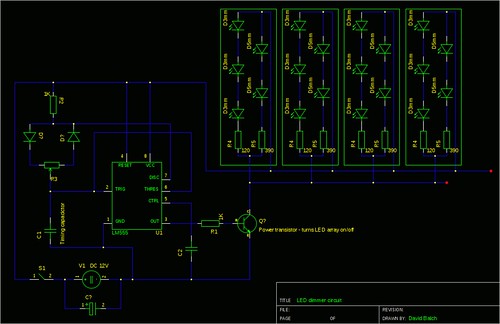It's great what you can learn with some time and t'interweb - when finding time between band, family, and the rest of real life, that is...
This LED wizard (and generally informative site) helped me realise that "forward voltage" is the same as "voltage" as generally used, but relating to correctly wired in components, rather than what's coming out of the power source.
My previous tests were under-driving the LEDs not by current, but by voltage: A 12V source isn't enough to power four 3.3V LEDs - obviously 4x3.3 = 13.2V.
So, rather than four LEDs in series, I can have up to three. Three seems too few though, so after trying some different combinations, I've decided each column will have three 5mm in series, in parallel with two 3mm LEDs in series. This will add up to 420mA, which at 12V is 5.04W.
After a bit more reading I realised that just slinging a potentiometer between the power source and the LEDs wouldn't work (safely at least), as regular potentiometers won't handle power around 5 watts.
Some helpful people on the sci.electronics.basics Usenet group answered my query about what to use instead, and the consensus was to use pulse width modulation - a PWM circuit based on the 555 timer.
Although the intention with the light frame was to do something without that level of complication, it's just accelerating my schedule a bit, as PWM is something I know I'll need for other projects I have in mind.
Here's what I've got so far:
That schematic is missing quite a few important details - like values of the capacitors, diodes, and resistors surrounding the 555 chip. Oh, and there'll be 3 times the number of LEDs.
I've not yet learnt exactly why this circuit should work - specifically how the current flows around the diodes - but the basic principle is that the discrete components around the 555 tell it how long to turn pin 3 on for (the pulse width), with the variable resistor (R3) allowing manual modification of that duration.
Pin 3 goes to the base (B) of a high power resistor, telling it when to allow current to flow between its collector (C) and emitter (E) - acting as a switch between the power and the LEDs.
That gives us: a small (safe) current through the pot, making the 555 turn the transistor on & off, which varies the power going through the LEDs - controlling their brightness. Hurrah!
Now I need to satisfy myself that I understand all the circuit, and figure out the values for those discrete components to get the timing I want, then I can figure out a list of what I need to buy (AKA Bill Of Materials).
There's a possibility that I'll revisit the LED/resistor configuration to see if I can make it more efficient with a higher voltage source, but it's too late in the evening to think about that now :-)

No comments:
Post a Comment